Frank-Starling Study guides, Class notes & Summaries
Looking for the best study guides, study notes and summaries about Frank-Starling? On this page you'll find 348 study documents about Frank-Starling.
Page 13 out of 348 results
Sort by
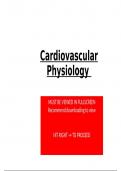
-
Cardiovascular Hemodynamics/Physiology
- Presentation • 28 pages • 2023
-
- $7.99
- + learn more
This is a PowerPoint presentation on the physiology of blood flow throughout the human cardiovascular system. It also dives into the mechanics of the heart and the cardiac cycle. It explains physical relationships including frank-starling law, cardiac output, the resistance of blood to the diameter of tubes, and many more. EKGs are presented at the end but if you need a more in-depth presentation on EKGs check out my other ones. This topic is very dense and attempts to build on concepts from...
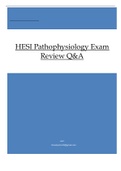
-
HESI Pathophysiology Exam Review & Practice Questions & Answers
- Exam (elaborations) • 22 pages • 2022
-
- $14.49
- 2x sold
- + learn more
What cholesterol is the good cholesterol? (Hint - remember LDL = lousy) HDL: the "good" lipoprotein; has a low lipid content and is used to transport cholesterol AWAY from the peripheral cells to the liver, where it undergoes catabolism and excretion; is increased with exercise; protects women until after menopause; smoking decreases HDL levels; 11. What kind of immunity do we get from vaccines? How about from mother to baby? How do you get active immunity? Vaccines: Acquired, Active, A...
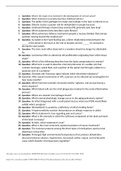
-
NR 507 Week 8 Final Exam Questions with Answers (May 2018).docx
- Exam (elaborations) • 5 pages • 2022
-
- $8.29
- + learn more
1. Question: What is the major virus involved in the development of cervical cancer? 2. Question: Which statement accurately describes childhood asthma? 3. Question: The ability of the pathogen to invade and multiply in the host is referred to as: 4. Question: Obesity creates a greater risk for dehydration in people because: 5. Question: Continued therapy of pernicious anemia (PA) generally lasts how long? 6. Question: Which statement best describes cystic fibrosis? 7. Question: What pulmo...
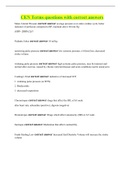
-
CEN Terms questions with correct answers
- Exam (elaborations) • 22 pages • 2023
- Available in package deal
-
- $13.99
- + learn more
Mean Arterial Pressure correct answer average pressure over entire cardiac cycle, better indicator of perfusion compared to BP, maintain above 60 mm Hg (SBP+ [DBPx2])/3 Pediatric bolus correct answer 10 ml/kg narrowing pulse pressure correct answer low systemic pressure, r/t blood loss, decreased stroke volume widening pulse pressure correct answer high systemic pulse pressure, may be transient and normal after exercise, caused by chronic (arterial disease) and acute conditions (aortic...
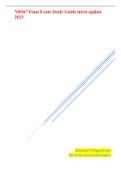
-
NR567 Final Exam Study Guide latest update 2023
- Exam (elaborations) • 30 pages • 2023
-
- $16.49
- + learn more
Therapeutic dosing and monitoring of warfarin (Coumadin) Treatment with warfarin should be initiated with standard doses of 5–10 mg. The initial adjustment of the prothrombin time takes about 1 week, which usually results in a maintenance dosage of 5–7 mg/d. The prothrombin time (PT) should be increased to a level representing a reduction of prothrombin activity to 25% of normal and maintained there for long-term therapy. When the activity is less than 20%, the warfarin dosage should be r...
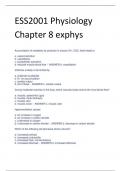
-
ESS2001 Physiology Chapter 8 exphys
- Exam (elaborations) • 6 pages • 2024
-
- $9.49
- + learn more
ESS2001 Physiology Chapter 8 exphys Accumulation of metabolic by-products in muscle (H+, CO2, heat) leads to a. vasoconstriction b. vasodilation c. sympathetic activation d. reduced muscle blood flow - ANSWER b. vasodilation VO2max is likely to be limited by a. substrate availability b. H+ ion accumulation c. cardiac output d. all of these - ANSWER c. cardiac output During moderate exercise in the heat, which vascular beds receive the most blood flow? a. muscle, splanchinic (gut) b...
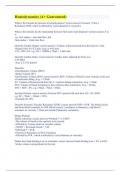
-
Hemodynamics (A+ Guaranteed)
- Exam (elaborations) • 11 pages • 2023
-
Available in package deal
-
- $11.19
- + learn more
What is the formula for pressure in hemodynamics? correct answers Pressure = Flow x Resistance (SVR, which is affected by vessel diameter or viscosity). What is the formula for the relationship between Flow and vessel diameter? correct answers F ∝ r⁴ e.g. 1mL radius = 1mL/min flow, but 2mm radius = 16mL/min flow. Describe Cardiac Output: correct answers -Volume of blood ejected from the heart in 1 min. -Ranges from 4 to 8 L/min; Avg. is 4-6L/min. -CO = HR x SV. e.g. CO = 72BPM x ...
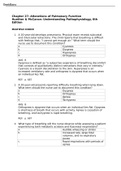
-
Chapter 27: Alterations of Pulmonary Function_With Rationales/ Huether & McCance
- Exam (elaborations) • 16 pages • 2023
-
- $8.82
- + learn more
Chapter 27: Alterations of Pulmonary Function Huether & McCance: Understanding Pathophysiology, 6th Edition MULTIPLE CHOICE 1. A 10-year-old develops pneumonia. Physical exam reveals subcostal and intercostal retractions. The child reports that breathing is difficult with feelings that, “I cannot get enough air.” What term should the nurse use to document this condition? a. Cyanosis b. Dyspnea c. Hyperpnea d. Orthopnea ANS: B Dyspnea is defined as “a subjective experience of b...
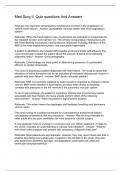
-
Med Surg II: Quiz questions And Answers
- Exam (elaborations) • 23 pages • 2023
-
- $12.49
- + learn more
What are two important compensatory mechanisms involved in the progression of systolic heart failure? - Answer- Sympathetic nervous system and renin-angiotensin system Rationale: When the heart begins to fail, mechanisms are activated to compensate for the impaired function and maintain CO. The primary compensatory mechanisms are: the Frank-Starling mechanism, neuroendocrine responses including activation of the SNS & the renin-angiotensin system, and myocardial hypertrophy A patient is ad...
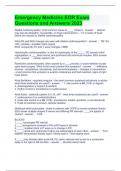
-
Emergency Medicine EOR Exam Questions and Answers 2023
- Exam (elaborations) • 31 pages • 2023
-
Available in package deal
-
- $20.49
- + learn more
Emergency Medicine EOR Exam Questions and Answers 2023 Dilated Cardiomyopathy: most common cause is ____. Others? alcohol; may also be idiopathic, myocarditis, or drugs (doxorubicin) -- 1 in 3 cases of heart failure are caused by dilated cardiomyopathy What PE and EKG changes are seen with dilated cardiomyopathy? PE: S3, JVD, crackles - possible mitral regurg EKG: nonspecific ST and T wave changes, LBBB Hypertrophic cardiomyopathy: is due to hypertrophy of the _____. PE reveals...
-
1
- ...
-
12
-
13
-
14
- ...

Do you wonder why so many students wear nice clothes, have money to spare and enjoy tons of free time? Well, they sell on Stuvia! Imagine your study notes being downloaded a dozen times for $15 each. Every. Single. Day. Discover all about earning on Stuvia


